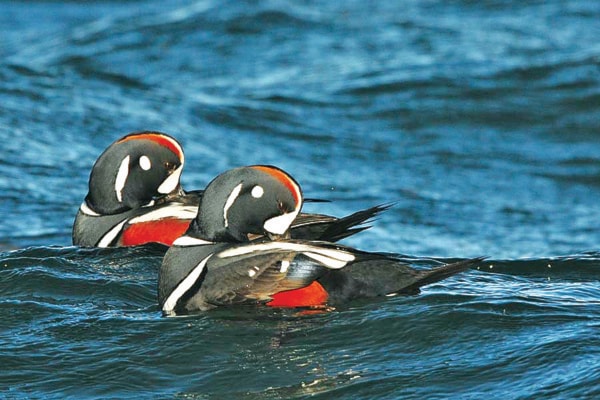As winter storms continue to pound our shores with high winds and heavy rain, even the hardiest of shorebirds are having a tough time riding out nature’s wrath.
Known to be expert boatmen, harlequin ducks are able to negotiate their way up freshwater currents and can tackle surging ocean surf.
Their name, Histrionicus Histrionicus, translated from Latin means “stage player or actor.” The Italian translation describes gaily painted clowns, which harlequin ducks certainly portray with their brilliant plumage and comical characteristics.
There are two distinct populations in North America, the Pacific coast ducks winter from Alaska to southern Oregon; they migrate east of the coastal mountains to breed in the pristine fast-running streams and rivers.
The much-smaller Atlantic populations winter from Nova Scotia southwards along the coast to Maine and Virginia; in the spring they make the long trek to Newfoundland en route to Greenland and the Arctic.
Harlequins are small sea ducks about half the size of a common mallard; they have round heads, stubby bills and stocky bodies. These ducks prefer to stay close to shore and are one of the easiest ducks to spot.
In our local area, harlequins can be seen along the shorelines around Goose Spit; fArther south Qualicum Beach is a favourite haunt.
Rivalling the wood duck and the eider duck, the male harlequins are one of nature’s most exquisitely marked ducks. The belly and wings are slate blue with chestnut flanks outlined with very distinct white stripes; they also have a very noticeable crescent shaped white patch at the base of their bill and a white dot around the ear.
Like most bird species, the females are the “plain Janes.” Their overall appearance is a dull brownish grey and they can be identified by three white patches on either side of the head.
Sometimes called “rock ducks,” harlequins have a habit of swimming and feeding in shallow rocky water and like to haul themselves onto the rocks to rest or preen.
Preening is very important to these ducks as they have extremely dense layers of feathers that trap air providing the duck with great insulation it also makes the ducks very buoyant enabling them to bob like corks in the rough surf.
Winter food for the harlequins include small crabs, snails, limpets, mussels, fish eggs and particularly herring spawn. They either dive for their prey in shallow water or pry the prey from the rocks with their powerful bills.
Late April, the harlequins are on the move, heading east to Banff National Park, which provides the clear, unpolluted, fast-flowing water these ducks need to successfully breed. Often the route takes them up narrow, rushing streams, which they navigate with their large powerful feet swimming or walking upstream against the current. They even portage around rapids on land.
In these breeding grounds they take advantage of the abundance of emerging insects, especially the black, May and stoneflies supplemented with fish eggs. Harlequin ducks have very high food requirements as they expend a lot of energy.
They also have a very high metabolism that means they need to spend a great deal of time feeding. Unlike larger ducks and geese they lack the ability to store large fat supplies.
This reminds us yet again how important it is to stay away from areas where water birds are feeding; causing a disturbance whilst they feed can mean a death sentence to them as they run out of energy before making a successful migration.
Harlequin ducks are very secretive about their breeding habits and rituals, nests locations pose a challenge for the observer, they are often found beside fast-flowing water or hidden under logs or vegetation in the forest or even in tree cavities and rocky ledges. Once the female has produced her eggs, the male heads back to the coast, the ducklings are hatched with fluffy down and are able to swim within 24 hours, however they remain with the mother for 50 days learning their life skills.
MARS rarely admits harlequin ducks and usually the prognosis for any sea duck species is poor due to their unique dietary needs and our ability to provide them with an acceptable habitat for their stay. Local populations of harlequin ducks are stable but the eastern populations are listed as endangered mainly due to habitat loss.
• • •
MARS will be at the Black Creek Hall Christmas Fair this Saturday. Please come and support us.
We have a variety of bird-related gifts, plus specially made Hot Chocolate eagles, and for a rewarding, unusual gift, sponsorships are available for the care of any patient or sponsoring an eagle or owl release.
For more information, please check our website and Facebook.
To report injured wildlife, please call 1-800-304-9968. For other information, phone 250-337-2021 or visit www.wingtips.org.
Sandy Fairfield is the educational co-ordinator for the Mountainaire Avian Rescue Society (MARS). The MARS column appears every second Friday.
